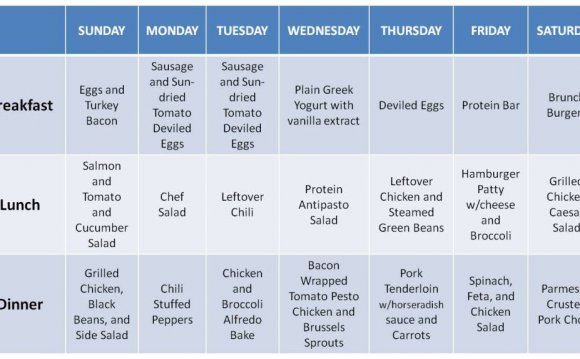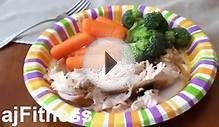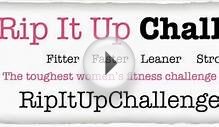
Most people know how to eat healthy, and know that they should — it’s just that when it comes down to implementing this knowledge, there’s a bridge that needs to be crossed from knowledge to action.
How do you actually eat healthy, instead of just knowing that you should eat healthy?
Create a meal plan, constructed with super healthy foods that you enjoy eating.
Now, there are three parts of that solution, if you look closely, and all three parts are equally important:
- Create a meal plan. Without this, you’ll just know what to eat, vaguely, but you need to actually make a plan and implement it (meaning, go shopping for the foods in the plan and actually cook the foods and eat them).
- Super healthy foods. A meal plan without this doesn’t get you to where you want to go. Build your meals around stuff that’s really good for you. You can add other stuff, of course, but the super healthy stuff should be the majority of the food.
- Food you really love. This is key. If you don’t enjoy the foods, you won’t stick with the plan for long. No one can eat food they don’t enjoy for more than a month or so (usually less). It’s why most diets fail — anyone can stick with a diet for a couple of weeks, but if you feel that you are suffering by eating it, you’ll fall off it after a little while. Instead, make sure you love your food. Add variety, of course, and mix up the plan every few weeks, but stick with foods you love.
Given those simple components, the solution doesn’t seem so hard, does it? And with a super healthy meal plan like this — one that you love — you can pair it with some exercise and get healthier than ever.
What follows are some of my building blocks. They aren’t the only possible building blocks, and you shouldn’t use them exclusively, but they’re a good starting point for anyone. Below those building blocks are some sample meals you can use, but only if you love these foods like I do. Instead of following it exactly, use it as a starting place, as a few ideas you can use to construct your own meal plan — with foods you love, not ones that I love.
Super Healthy Building Blocks
Spinach and other greens. Spinach is my favorite of the greens, but other good ones include kale, bok choi, collards, dark green lettuce (skip iceberg), and other similar greens. Try to build a couple of your meals around these greens, as they are high in fiber, vitamins and minerals. And best yet: super low in calories. You can eat a whole plate of greens and while they can fill you up, you couldn’t possibly get fat on them (unless you added a bunch of butter or fatty dressing or something like that).
Avocadoes. I love these things. Full of good fats and good flavor, avocadoes are perfect for salads, sandwiches, wraps and more.
Tomatoes. There are other good fruits and veggies, but tomatoes are one of my favorites, not only for their nutritional content but because of the flavor they add to any dish — salads, sandwiches, pastas, soups, anything.
Fruits. Don’t worry about their “carb content”. Fruits are incredible snacks, because they are filled with fiber and vitamins but are low in calories. I eat lots of apples, oranges, bananas, mangoes, pears, grapes, melons. I like to get a big back of small apples and just munch on them whenever I’m hungry. I also add fruits to all kinds of uncooked meals, chopped up or as a side dish.
Berries. They’re fruits, but they’re so special to me that I add them as a separate item. I absolutely adore berries. They are like a dessert to me, eaten cold and slowly and with my eyes closed. I add them to cereal, yogurt, smoothies, desserts, oatmeal and more … and of course just eat them by themselves.
Nuts. Full of fiber and good fats and protein. I like to chop them up and put them in hot cereal or salads or stir frys, or just eat them raw and whole as snacks (almonds are my favorites). I also enjoy almond butter instead of peanut butter (although I eat both).
Beans. Great sources of fiber and protein, low in calories, you can eat beans all day long. I like them in chili, soups, tacos and more. Get a variety — red, black, pinto, white, lentils.
Whole grains. This is a broad category that includes all kinds of cereals, breads, wraps, brown rice, pizza dough, and more. Try to go for as much whole grain as possible — if you see “wheat flour” or “enriched wheat flour” it’s not as good. I especially like sprouted grains, such as Ezekiel sprouted bread or English muffins or cereals. Oatmeal is good (avoid instant) as is muesli.
Olive or canola oil. You need fats, but they should be the good kind. Avoid saturated, although a little saturated fat is fine. I usually use olive oil or canola oil, although there are other good ones too. Again, nuts and avocadoes also provide good fats. I also use ground flaxseed on lots of things for fiber and good fats.
Lean protein. As a vegetarian, I eat lean vegetable protein — lots of soy protein and beans and nuts. Whole grains also contain protein, as do other veggies. It’s not hard to meet your daily requirements, even with lots of exercise raising your requirements. However, if you’re not vegetarian, fish and lean poultry are best, and lean red meat can be included if you don’t eat too much of it. Note: Please, let’s not get into another debate about soy protein or meat! Let those sleeping dogs lie.
Lean calcium. I try to stick to soy sources, but that’s not necessary for good health. However, try to stick with lower-fat versions, as whole dairy can have too much saturated fat. Lower-fat milk, yogurt, and cheese are good choices. Soy milk and yogurt are great because they are very low in saturated fat.
A Sample Meal Plan
This is not something you should just adopt wholesale, without making changes. In fact, if these are foods you don’t like, ditch the whole thing, but use it just to get an idea of what you can do. These are foods I love to eat, but you should choose your own.
Also remember that I’m not a dietician. I’ve run these meals through online calculators, and most of the time you’ll get plenty of all the things you’ll need, from protein and healthy fats to the major vitamins and minerals, including calcium and iron. But don’t take my advice as the advice of an expert.
Each day, you would choose one of the meals from each category (more from the snacks), or mix them up if you like. Be sure to get a variety, and change the options every few weeks or so.
Breakfasts
- Hot oatmeal (using rolled oats) with chopped fruits or dried fruits, flaxseed, and/or berries.
- Kashi cereal with soymilk and berries or other fruits.
- Sprouted grain toast with almond butter, chopped fruits on the side.
- Fried brown rice — fry up with olive oil, onions, mushrooms, green veggies, tofu, soy sauce or tamari sauce. You can throw in some corn or carrots or other veggies.
INTERESTING VIDEO












